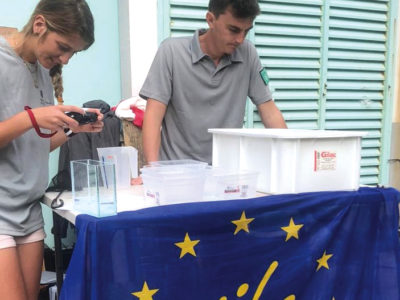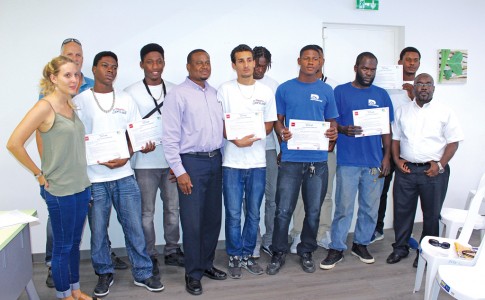As part of Life BIODIV'OM, the National Nature Reserve of Saint-Martin, in partnership with the French company Ecocéan, has deployed innovative methods in their territory to obtain more knowledge about the Nassau Grouper and the Mérou giant.
The life cycle of reef fish
This cycle begins with a phase of a few days to several months in the open ocean in the form of a transparent larva (oceanic planktonic phase) which will end with an adult phase at the level of coral reefs. Between these two phases, reef colonization takes place during which the post-larvae present in the ocean undergo a significant morphological transformation and then return towards the coasts.
This colonization phase takes place mainly around the new moon or black moon, the post-larvae taking advantage of the absence of light to avoid predation. The fish post-larva is therefore the last larval stage of their ocean life cycle. In the vast majority of cases (more than 95%) these post-larvae disappear by natural predation or failing to reach an adequate habitat after 10 days.
The PCC
PCC (Post-Larval Capture and Culture) is an innovative technique for sampling at sea and rearing artificial post-larvae in an artificial environment. The PCC consists in taking post-larvae present in the ocean before they undergo this high mortality and to raise them to more advanced stages in order to release them and to reinforce the populations of fish in the natural environment. This method also makes it possible to know the identity of the species and the period at which they settle in coastal waters.
La capture
Concretely, there are two main techniques for capturing the post-larvae of fish: the nets placed on the reef crest which filter the masses of water arriving on the reef and which thus trap the post-larvae and the luminous floating attractors, called CARE, which use the phototrophic character of the majority of the post-larvae to facilitate their collection. The choice of method depends on the location and purpose of the project, the cost and its ease of use. In Saint-Martin, the light trap method is currently used to capture post-larvae.
These collectors are installed at sunset during new moons or black moons over areas 15 to 30 meters deep, then will be raised at sunrise after a full night of fishing. The devices are moored to a ballast and provided with air chambers to ensure flotation, the post-larvae evolving on the surface. The next day, the larvae are collected in a PVC collector.
The breeding
Once on the ground and after careful sorting, the post-larvae are placed in a breeding aquarium on a farm or in the laboratory. During this stage, the post-larvae are sorted and reared in experimental tanks up to the juvenile or adult stage.
The BioHut are artificial nurseries: small habitats of great complexity installed to allow the young larval stages to hide from predators and to grow in complete safety.
BioHut
These BioHut limit predation by allowing juveniles or post-larvae to hide inside this system composed of barriers blocking passage to large predators. Another benefit of this system is the supply of food within the habitat itself, becoming the support where a diverse fauna and flora develops (grids, empty oyster shells, cords made of coconut fibers, etc.).
Easy to set up (40 BioHut per day) and composed of wood, steel and mollusc shells, these BioHut can be installed on port infrastructures or marinas to restore the ecological nursery function lost by planarization of the substrate.
In Saint-Martin, these artificial nurseries are installed on structures such as artificial habitats, moorings, a pontoon and in the mangrove.
Ultimately, these biodiversity huts may contain more than 150 species of flora and fauna. These innovative devices will make it possible to monitor the arrivals of groupers and other species of fish, which have apparently escaped the CARE (light collectors).
Ecocean
Ecocean is a French company (Montpellier) which acts and innovates in favor of aquatic biodiversity. Founded in 2003, the company has developed the collection and breeding of post-larvae (PCC) for the sustainable development of marine resources and the conservation of biodiversity in marine ecosystems. Now a world leader in PCC technique, Ecocean is associated with the LIFE BIODIV'OM program as a partner of the National Natural Reserve of Saint-Martin.
Trained by the Ecocéan company in October 2019, the agents of the National Nature Reserve of Saint-Martin thus deployed the PCC method using light traps and set up BioHut on the island. As part of LIFE BIODIVOM, the Reserve has set up these protocols in order to study the arrival flows of post-larvae on shallow coastal waters, in particular two species of grouper: the Nassau grouper and the giant grouper , both threatened globally. These innovative techniques will make it possible to acquire new knowledge about grouper post-larvae, such as the period of colonization and the species concerned.
The AGRNSM, as part of LIFE BIODIV'OM, will also be involved in the transfer of know-how related to the PCC and BIOHUT, to their local counterparts and more particularly the staff of the Territorial Environment Agency ( ATE) from Saint-Barthélemy.
Two endangered grouper species
The Nassau Grouper and the Giant Grouper are two globally threatened species. On the island of Saint-Martin, the Nassau grouper is observed but its population has dropped considerably worldwide. The presence of the giant grouper is now anecdotal in the West Indies. The stocks of the species have collapsed and the species, originally present on the west and east coast of the Atlantic Ocean, is no longer only present in the West area.
In addition to the lack of regulation, other threats such as human activities contribute to the reduction of their populations such as the destruction of essential grouper habitats by coastal development, discharges of wastewater, clearing of the coastline and over- frequentation of reef areas. In addition, coral reefs, a habitat frequented by the Giant Grouper and the Nassau Grouper, suffer particularly from the consequences of global changes, leading to a reduction in coral cover and episodes of coral bleaching.
7,257 total views













No comments